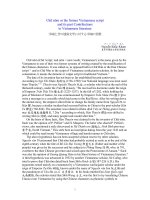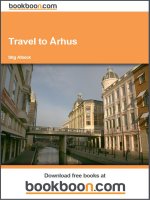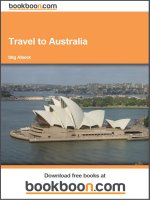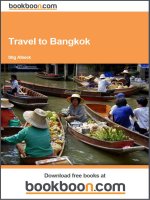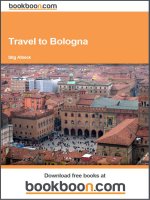Travel to Taipei & Kaohsiung pptx
Bạn đang xem bản rút gọn của tài liệu. Xem và tải ngay bản đầy đủ của tài liệu tại đây (3.72 MB, 40 trang )
Download free ebooks at bookboon.com
Download free ebooks at bookboon.com
Taipei & Kaohsiung
© 2008 Stig Albeck & Ventus Publishing ApS
Translation: Liz Bramsen
All rights and copyright relating to the content of this
book are the property of Ventus Publishing ApS, and/or its
suppliers. Content from ths book, may not be reproduced
in any shape or form without prior written permission from
Ventus Publishing ApS.
Quoting this book is allowed when clear references are made,
in relation to reviews are allowed.
ISBN 978-87-7061-281-4
1st edition
Pictures and illustrations in this book are reproduced according
to agreement with the following copyright owners
Taiwan Tourismus.
The stated prices and opening hours are indicative and may
have be subject to change after this book was published.
Download free ebooks at bookboon.com
Taipei & Kaohsiung
4
Kapiteloverskrift ONLIBRI
Download free ebooks at bookboon.com
Taipei & Kaohsiung
5
A visit to Taipei/⥑ർᏒ
& Kaohsiung/㜞㓶
www.tc.tcg.gov.tw
www.kaohsiung.gov.tw
www.tbroc.gov.tw
Chinese Taiwan offers magnificent nature,
traditional Chinese architecture, exciting museums
and a fascinating modern society – and all this can
be found in one package on Taiwan Island, which
has a perfect size for traveling around a bit and
seeing more than just the big cities of Taipei to the
north and Kaohsiung to the south.
Taiwan is the place where Chiang Kai-Shek created
capitalist China after the people’s revolution on the
mainland, and of course, it is just as authentically
Chinese as is the People’s Republic, but with its own
special charm.
Museums with extensive collections are found
mostly in the capital, Taipei, which also has many
large, beautiful public buildings. Kaohsiung also has
a lot to offer, not least modern buildings, a good
garden atmosphere and beautiful nature near the
center of the city.
It is easy to understand why the Portuguese called
Taiwan Formosa, ’The Beautiful Island’.
Have a good trip!
A visit to Taipei & Kaohsiung
Download free ebooks at bookboon.com
Taipei & Kaohsiung
6
Historical Outline
Taipei
During the Yuan dynasty, Chinese from the
mainland began visiting Taiwan Island. However, it
was not until the Ming dynasty that large numbers of
Chinese began to settle there permanently.
In the 1600s, European trade and colonial powers
began to exert greater influence on the Southeast
Asian area. First, the Dutch came to Taiwan and
then the Spanish. This lasted until 1661, when
Zheng Chenggong, who was loyal to the emperor,
took control of the island and ousted the foreigners.
Zheng ruled until 1683 when the Qing dynasty’s
armies came and took control of Taiwan. From then
on, the island was ruled directly from Beijing.
Around the beginning of the 1700s, immigrants –
primarily from the province of Fujian – applied to
the emperor for permission to establish themselves
more permanently in the Taipei area. Due to its
favorable position along the most important
waterways, the city of Mengjia became the most
important trading post. The area developed little by
little through the century.
In the 1850s, under Qing emperor Xianfeng,
Taiwan’s development took a great leap forward.
Trade on the seas increased greatly and more and
more settlers came to the area. After a little over
twenty years, it became necessary to establish an
actual organizational and political unit in the area. In
1875, the imperial court established the province of
Taipei with a base at Fort Dajiarui, in what is now
the Zhongzheng district.
Just a few years later, in 1882-1884, Taipei was laid
out in a rectangular shape behind city walls. There
were five entry gates. As early as 1885, main roads to
the surrounding towns were constructed.
In 1895, Taiwan became part of Japan, and the local
Japanese government gathered a number of towns
in the Taipei area into one administrative area. In
1897 and in 1901, extensive city planning was
begun in the city of Taipei itself. The city plans, the
tearing down of the city walls and the new political
structure (a large merging of counties in 1920)
became the foundation of the big city of today.
Development took place quickly. In 1920 170,000
inhabitants lived here, while an ambitious plan in
1932 increased the number to 600,000 within just a
few years.
In 1949, the Koumintang Party established its
government in Taipei, and thus a number of new
construction projects were started. The city was
now to house all the administrative facilities that
had once been on the Chinese mainland.
Innumerable housing units were also built for the
increasing numbers of residents during the
following decades. Around 1970, there were 1.5
million residents; in 1990, there were more than 2.5
million.
Taiwan’s great investment in the development of
trade and industry created a big economic boom
from the 1950s onward, and as a government city,
Taipei was at the center of much of the
development. Fantastic museums, numerous metro
lines, some of the world’s highest skyscrapers, and
beautiful, impressive memorials to the nation’s
fathers, Sun Yat-Sen and Chiang Kai-Shek, were
among what was built.
Kaohsiung
Kaohsiung’s history begins in 1405 when settlers
came here from the Chinese mainland. There was,
however, no real development of townships during
the first centuries. The activity in the area was
mainly due to the Western colonial powers,
especially the Dutch.
When Zheng Chenggong threw the Dutch out and
made Taiwan completely Chinese in 1661, an
administrative unit was established with Kaohsiung
Historical outline
Download free ebooks at bookboon.com
Taipei & Kaohsiung
7
as its main town. In 1664, it changed its name to
Wan Nien Chow. It grew quickly as many new
Chinese citizens settled there and the name was
changed once again, to Takao. The following
centuries were marked by different forms of
government and a relative stagnation of growth.
In 1895, Taiwan became Japanese. This brought a
new period of growth, especially since the town’s
natural harbor was developed. In 1925, Kaohsiung’s
status was changed to that of a real city and its
industry grew.
After the shift to Chinese government in 1945,
Kaohsiung quickly became Taiwan’s next-largest
city. Its hub was the well-placed natural harbor,
which is now the largest on Taiwan and one of the
largest in all of Asia. A great deal of Taiwan’s many
export products are shipped from here. The
positive economic situation brought with it the
building of numerous skyscrapers and large parks,
museums and other cultural developments. Today,
more than 1.5 million people live in the busy
metropolis.
Historical outline
Download free ebooks at bookboon.com
Please click the advert
Taipei & Kaohsiung
8
Tour 1: Taipei/⥑ർᏒ
1. The Longshan Temple/Longshan Si/
啡ቅᇎ
Guangzhou Street 211, Wanhua
www.lungshan.org.tw
MRT: Longshan Temple
Taipei’s Longshan Temple was founded by the Han
Chinese, who came from Fujian on the mainland. It
was built in 1738 and, in addition to religious
purposes for both Buddhists and Taoists, its
function was as a social gathering place for those
who moved to the city.
Over the years, the temple has been destroyed time
and again by earthquakes and fires, but it has been
quickly rebuilt every time and today it is one of
Taiwan’s most important historical buildings.
Tour 1: Taipei
Download free ebooks at bookboon.com
Taipei & Kaohsiung
9
2. The Historical Museum/
Guoli Lishi Bowuguan/ゟ⅋म⠽仼
Nanhai Road 49, Zhongzheng
www.nmh.gov.tw
MRT: Chiang Kai-Shek
The National Museum of History contains finds
from large parts of China as well as from Taiwan.
The museum was built in 1955. Among the
collections are pottery from the Tang dynasty and
numerous bronze artifacts.
3. The Presidential Building/
Zong Tong Fu/㐑㍅ᑰ
Chung-King South Road 122, Zhongzheng
www.president.gov.tw
MRT: Ximen
Taiwan’s presidential building was constructed while
the island was occupied by Japan. At the time, it
served as a residence for the Japanese governor.
During World War II, the building was destroyed,
but it was rebuilt as early as in 1946. One can take a
guided tour of the Presidential building, which is one
of Taiwan’s characteristic structures.
4. The National Taiwan Museum/Guo
Li Taiwan Bowuguan/ゟ㟎☷म⠽仼
Xiangyang Road 2, Zhongzhen
www.ntm.gov.tw
MRT: NTU Hospital
The National Taiwan Museum mainly exhibits an
exciting natural history collection. The notable
building was built in European style in 1915 – a
combination of Renaissance and Baroque with
Greek pillars.
5. The Chiang Kai-Shek Memorial
Hall/Guoli Zhongzheng Jiniantang/
ゟЁℷ㋔ᗉූ
Jhongshan South Road 21
www.cksmh.gov.tw
MRT: Chiang Kai-Shek
When Chiang Kai-Shek, the father of Taiwan, died
in 1975, a committee was formed to plan the
construction of a memorial for him. The result was
this impressive memorial hall, mausoleum and park
that together form one of Taiwan’s biggest
attractions. The memorial area was dedicated on
April 5
th
, 1980, the five-year anniversary of his
death.
Tour 1: Taipei
Download free ebooks at bookboon.com
Taipei & Kaohsiung
10
The central, white building with the blue roof is 70
meters high. The doors at the end of the 89 steps
going up to the hall itself are 16 meters high and
weigh 75 tons. The 89 steps symbolize the age he
reached.
In the memorial hall, there is a 25-ton bronze statue
of Chiang Kai-Shek; the building also holds a
museum. In the surrounding memorial park, which
covers about 55 acres, Taiwan’s National Theater
and the National Concert Hall are situated.
6. The Sun Yat-Sen Memorial Hall/
Guoli Guofu Jinianguan/
ゟ⠊㋔ᗉ仼
Jen Ai Road 505
www.yatsen.gov.tw
MRT: Sun Yat-Sen Memorial Hall
The mighty memorial hall for Sun Yat-Sen, the
founder of the Chinese republic, was finished in
1976. Originally, the hall was only intended to depict
Sun Yat-Sens thoughts and deeds at the close of
Qing-dynasty China and the establishment of
modern China. However, as time went on, a number
of different activities came to take place here.
The memorial hall is built as a traditional Chinese
building. Inside is a six-meter-high statue of Sun
Yat-Sen.
7. Taipei 101/㟎࣫ 101
Shifu Road 45
www.tfc101.com.tw
MRT: Taipei City Hall
With its 101 stories and 448 meters, Taipei 101 is
the tallest building in the world when the height of
antennas and TV towers are not included. The
building was completed in 2003 and opened in 2004.
Taipei 101 is unique in many ways. The world’s
fastest elevators shoot up to the top at a speed of
63 kilometers per hour. In this way, one reaches the
observation deck on the 89
th
floor in only 39
seconds. On the 88
th
floor, a 660 kilo device has
been built in to stabilize the building against
earthquakes and typhoons.
Inside of Taipei 101 are a six-story shopping center,
restaurants and different activities as well as offices.
The building’s entire area covers 450,000 square
meters.
8. The North Gate/Taipei Bei Men/
ৄ࣫࣫䭔
Yenping S. Road/Poai Road
MRT: Ximen
In 1879, the magistrate of the province ordered city
walls to be built around Taipei. At first, the task
seemed impossible to carry out, but a few years
later in 1884, a wall almost five kilometers long was
finished. It included five city gates. One of these is
the North Gate, also called Cheng-En. Of all the
city gates, only this one is preserved in its original
style from the 1800s.
9. Dihua Road/Dihua Jie/䖾࣪㸫
Dihua Road
MRT: Shuanglian
For many of Taipei’s inhabitants, Dihua Road is
one of the best places to buy traditional goods. The
street is exciting because many of the old houses in
Taipei are found here, so it is like visiting a city of
bygone days.
Tour 1: Taipei
Download free ebooks at bookboon.com
Please click the advert
Taipei & Kaohsiung
11
10. The Confucian Temple/
Kong Miao/ৄ࣫Ꮦᄨᒳ
Dalong Street 275
www.ct.taipei.gov.tw
MRT: Yuanshan
The Confucian Temple exudes peace and
graciousness through its architecture. It is a building
that lives up to Confucius’s thoughts on peace and
harmony, and it is one of the temples in Taipei most
highly recommended for a visit.
11. The Paoan Temple/Paoan Kung/
ֱᅝᆂ
Hami Street 61, Datong
www.paoan.org.tw
MRT: Yuanshan
The elegant Paoan Temple was founded in honor of
Baosheng Dadi, the god of medicine. The temple
was built by settlers from Tongan in the province of
Fujian on the Chinese mainland. The first temple
buildings were completed in 1755. The temple is one
of the three major ones in Taiwan.
12. The Grand Hotel/
Yuan Shan Da Fandian/೧ቅ仃ᑫ
Chung Shan N. Road 1
www.grand-hotel.org
MRT: Jiantan
The Grand Hotel is a modern hotel built in a style
modeled after the imperial Chinese style. The
building impresses with its large Chinese-style roof,
which is the largest of its kind in the world.
Tour 1: Taipei
© Deloitte & Touche LLP and affiliated entities.
360°
thinking
.
Discover the truth at www.deloitte.ca/careers
© Deloitte & Touche LLP and affiliated entities.
360°
thinking
.
Discover the truth at www.deloitte.ca/careers
© Deloitte & Touche LLP and affiliated entities.
360°
thinking
.
Discover the truth at www.deloitte.ca/careers
© Deloitte & Touche LLP and affiliated entities.
360°
thinking
.
Discover the truth at www.deloitte.ca/careers
Download free ebooks at bookboon.com
Taipei & Kaohsiung
12
13. The Martyrs’ Memorial/
Zhong Lie Ci/ᖴ௺⼴
Bei-an, Jhongshan 139
MRT: Jiantan
This impressive building complex from 1969, built in
the imperial style of Beijing under the Ming dynasty,
commemorates all those who were killed in China’s
wars. The area is studded with pavilions, bell towers,
drum towers, palace-like buildings, etc., so it is
recommended that you spend some time there.
14. The National Palace Museum/
Guoli Gugong Bowuyuan/
ゟᬙᆂम⠽䰶
Chih-Shan Road 221
www.npm.gov.tw
MRT: Shilin
The National Palace Museum has one of the
world’s finest collections of historical Chinese
objects and works of art. The large exhibition is
part of an entire collection which was divided into
two in the 1930s lest the many valuables fall into
the hands of the Japanese. When the People’s
Republic of China was established, this part of the
collection was taken to Taipei. The other part is
presently on exhibit in the Palace Museum in the
Forbidden City in Beijing.
Tour 1: Taipei
Download free ebooks at bookboon.com
Taipei & Kaohsiung
13
Tour 2: Kaohsiung/㜞㓶
15. The Chichin Lighthouse/
Tsijin Dengta/᮫⋹➜ศ
Chihou
The Chichin Lighthouse on Chihou Mountain was
built in 1883. The eleven-meter-high lighthouse was
extensively renovated in 1918. There is access to the
lighthouse for visitors.
16. The Tienhou Temple/Tienhou Kung/
ৢᆂ
Miaocheng Road 86
The Tienhou Temple is one of Kaohsiungs’s oldest
buildings, built in 1691. The temple is dedicated to
the sea-goddess Matsu, who protects sailors and
fishermen.
17. The former British Consulate/
Jiu Yingguo Lingshiguan/㟞㣅䷬џ仼
Lian-Hai Road
The building, which once housed the British
Consulate, was built in 1858 as the first consulate in
Taiwan. In the building, there are a number of
historical effects, maps and models exhibited,
turning it into a sort of historical and cultural
musuem.
The consulate building is beautifully placed on a
hilltop with a view over the Hsitzu Bay.
18. Shouzhan Park/Dongwuyuan/
ࢩ⠽೦
Shouzhan Park
Shouzhan Park is beautifully located in the hills
between Kaohsiung’s center and the sea. There are
lovely vantage points here, and if one is lucky, one
can see some of the Taiwanese monkeys. The city’s
zoological gardens are also found in the park.
On a stroll through the park one can see the large,
beautiful Yuanheng Temple/ర੧ኹ, which is one
of Kaohsiung’s most important temples. It was
originally built in 1697. The present buildings are a
reconstruction from 1926.
19. Tour of the harbor
Kaohsiung’s harbor is Taiwan’s largest and one of
the most significant in all of Asia. There is constant
activity among the large ships and on the impressive
quays. One can also sail along Love River on a
sightseeing tour.
20. The Holy Rosary Cathedral/
Tianzhujiao Meiguitang/Џᬭ⥿⩄ූ
Wu Fu 3rd Road 151
The Holy Rosary Cathedral was first established in
1860 and rebuilt in its present dimensions in 1929.
It is Kaohsiung’s oldest Catholic church. Inside one
can see a statue of the Virgin Mary from 1863.
Tour 2: Kaohsiung
Download free ebooks at bookboon.com
Please click the advert
Taipei & Kaohsiung
14
21. Tuntex 85 Sky Tower/Dong Dishi
Jiantai Dalou/ᵅᏱᓎৄῧ
Tzu-Chiang 3rd Road 1
www.gfk.com.tw
Tuntex 85 Sky Tower is Kaohsiung’s highest
building and is only surpassed by Taipei 101 on
Taiwan. The modern skyscraper is 348 meters high
and opened in 1997. The building is
architectonically inspired by the Chinese character
催, which is the first part of the city’s name. Inside
the tall building there is a hotel which is surpassed
in height only by the Jin Mao building in Shanghai.
22. The Sanfeng Temple/
Sanfengkung/ϝዄ㾔
Hebei 2nd Road 134
The Sanfeng Temple was built in 1672 as a pioneer
construction in the category of two-storey temples.
In 1964, the temple was torn down due to an
expropriation, and the rebuilt version stood on its
present spot in 1972. The temple is built in the
imperial style of northern China.
Tour 2: Kaohsiung
Increase your impact with MSM Executive Education
For more information, visit www.msm.nl or contact us at +31 43 38 70 808
or via
the globally networked management school
For more information, visit www.msm.nl or contact us at +31 43 38 70 808 or via
For almost 60 years Maastricht School of Management has been enhancing the management capacity
of professionals and organizations around the world through state-of-the-art management education.
Our broad range of Open Enrollment Executive Programs offers you a unique interactive, stimulating and
multicultural learning experience.
Be prepared for tomorrow’s management challenges and apply today.
Executive Education-170x115-B2.indd 1 18-08-11 15:13
Download free ebooks at bookboon.com
Taipei & Kaohsiung
15
23. The Grand 50 Tower/Chang Ku
World Trade Center/䭋䈋Ϫ䊓Ёᖗ
Minzu 1st Road
The Grand 50 Tower is named after its number of
stories. When the building was finished in 1992, its
222 meters made it Taiwan’s tallest. The Grand 50
Tower takes its inspiration from the Chinese pagoda
style and is one of Kaohsiung’s most characteristic
buildings.
24. The Science and Technology
Museum/Kuoli Kehsue Kongyi
BowuKuan/ゟ⾥ᅌᎹ㮱म⠽仼
Chiuju 1st Road 720
www.nstm.gov.tw
This museum is one of Kaohsiung’s leading
scientific museums. It opened in 1997 and gives
curious souls with a hunger for knowledge much
good information through exciting exhibits on
science and technology.
25. Cheng Ching Lake/
Cheng Tsing Hu/╘⏙
Dabei Road 32, Niaosong
Cheng ching means crystal clear, and this beautiful
lake is actually part of Kaohsiung’s drinking water
supply. The lake is the largest in the area, and in
addition to several activities for the many visiting
families, the surrounding park contains many
historically inspired buildings.
Immediately after the majestic entry gate, there are
two large pavilions in imperial Chinese style. One
holds a freshwater aquarium, the other a saltwater
one. Another aquarium, Ocean World, has been set
up in a 200-meter long underground tunnel dug in
1961 as a protection against atomic weapons.
The park’s most characteristic building is the 43-
meter high, seven-story Chunghsing pagoda. It is
possible to go up to the top where there is a
wonderful view of the area. At the shore of the lake
opposite the entrance to the park, there are three
especially picturesque small pavilions in traditional
Chinese style.
26. The Lotus Lake/Lian Hua Hu/㫂㢅
Tsui Hua Road 145
The area around the Lotus Lake in northern
Kaohsiung is a big, beautiful recreational area where
many of the city’s sights are found. It is a lovely
oasis after the metropolitan atmosphere of the city
center.
26a. The Confucian Temple/Kong Miao/
ᄨᒳ
Kaohsiung’s impressive Confucian temple is the
largest one in Taiwan. The architectural style is
traditionally Chinese from the time of the Sung
dynasty.
26b. The Spring and Autumn Pavilions/
Chun Tsiu Ke/
⾟䭷
These two great pavilions stand out in contrast to
modern Kaohsiung. This complex was built in 1951.
Centrally placed, there is a statue of the goddess of
mercy, Kuanyin, riding on a dragon. Legend says
that Kuanyin was seen above the clouds riding on a
dragon, and that believers were to build a
monument between the Spring and Autumn
Pavilions based on this vision. That is the story of
the Pavilions.
Tour 2: Kaohsiung
Download free ebooks at bookboon.com
Taipei & Kaohsiung
16
26c. The Dragon and Tiger Pagodas/
Long Hu Ta/啡
啡㰢ศ
The two magnificent seven-story pagodas carry a
very beautiful meaning for the Chinese. The entry to
the pagodas goes through the throat of the dragon,
but the exit goes through the tiger’s mouth. This
turns misfortune to luck.
Inside there are portraits of successful and
respected Chinese as well as pictures of scenes from
both heaven and hell. The idea is to inspire to the
performance of good deeds in one’s life as well as
to give frightening examples of the consequences of
evil intentions and deeds
27. The Art Museum/Mei Shu Kuan/
㕢㸧仼㎆キ
Mei Shu Kuan Road 20
www.kmfa.gov.tw
Kaohsiung’s art museum has a collection consisting
of a number of interesting local works of art,
among other things. There are exhibitions with
changing themes as well. There is a sculpture park
in connection with the museum.
Tour 2: Kaohsiung
Download free ebooks at bookboon.com
Please click the advert
Taipei & Kaohsiung
17
Day Tours from Taipei
28. Tanshui/⎵∈
Tanshui, 25 km N
Tanshui was the big port of the 1800s on the
northern coast of Taiwan. Today, it is a favorite spot
for outings among the people of Taipei.
Historical buildings include the old Spanish San
Domingo fort, built in 1629. The Dutch captured
the fort from the Spanish before it came into
Chinese hands at a later date. San Domingo is a very
good example of earlier buildings on the island made
by the European colonizers.
The impressive Guandu Temple in traditional
Chinese architectural style is also one of Tanshui’s
important sights.
The maritime atmosphere is a sightseeing attraction
in itself. Tanshui is known for its innumerable
restaurants, which serve fresh fish and shellfish.
Take your time when you go there and choose a
meal from the many exciting dishes.
29. Shihmen/䭔
30 km N
www.necoast-nsa.gov.tw
Shihmen lies at Taiwan’s northernmost point, Cape
Fuguei/ን⾆ⷺ. The entire coast is most
enchanting with its bays and jagged cliffs and
Shihmen is really a place worth seeing. Shihmen is a
natural cave shaped by the erosion of the tide over
time. This spot, with its large, naturally created arch,
lies close to both the road and the sea – it is
therefore one of the best spots to enjoy a view of
the ocean.
Day Tours from Taipei
Get “Bookboon’s Free Media Advice”
See the light!
The sooner you realize we are right,
the sooner your life will get better!
A bit over the top? Yes we know!
We are just that sure that we can make your
media activities more effective.
Download free ebooks at bookboon.com
Taipei & Kaohsiung
18
Shihmen can be the starting point for a long drive
along the coast in northeastern Taiwan. The entire
area is a nature reserve, with small bays, jutting cliffs,
green mountains, sandy beaches, rivers and eroded
coastlines. Amid the beautiful scenery there are
picturesque lighthouses, terraces where rice is grown,
and many other exciting things.
30. Keelung/䱚
25 km NE
www.klcg.gov.tw/en
Keelung is one of Taiwan’s largest ports. As far back
as 1600, it was the home of Japanese pirates. Later
the town was conquered by various colonial powers,
one after the other, beginning with the Spanish.
There are still ruins of a fortress in the mountains
which stems from those times.
Keelung’s greatest attraction is the 22.5 meter high
statue of Kuan Yin, the Buddhist goddess of mercy.
One can go up into the statue, from which there is a
wonderful view over the ocean and of Keelung’s big,
busy natural harbor.
30a. The Pingshi Waterfalls/
Pingshi Pubu/
ᑇ⑾◥Ꮧ
Just south of Keelung lies the area which holds the
greatest concentration of waterfalls in Taiwan.
There were once a number of coal-mines here, but
now the area has been left to nature and to the
tourists, who can take a train ride through the lovely
scenery. The broad waterfalls at Pingshi are among
the most beautiful.
31. Fulung/⽣䱚
40 km E
At Fulung, on the northeastern coast of Taiwan, is
the longest beach on the island. More than three
kilometers of wonderful, sandy beach awaits visitors
at Yenliao.
The beach has played a role in history – it was here
that the Japanese landed when they took over the
island at the end of the 1800s. There is a memorial
marker here for those who died in the battles.
32. Taiwan’s Hot Springs
At various places on the island, there are many hot
springs, which, in addition to any healing effects
they may have, certainly promote a feeling of well-
being. The springs are spread out over the entire
area of Taiwan, and there are some in the
neighborhood of Taipei – for example in Jiaosi and
generally in the Ilan Province southeast of Taipei.
The town of Jiaosi has numerous public bathhouses
where one can enjoy different types of baths.
Day Tours from Taipei
Download free ebooks at bookboon.com
Taipei & Kaohsiung
19
33. Sansia/ϝዑ
20 km SW
www.sanshia.tpc.gov.tw
Sansia is a cozy old town and certain parts of it
present a sharp contrast to Taipei. In the narrow
streets (especially Minquan Street) with their low
houses, it is as though one has stepped back in time.
There is a wonderful atmosphere and lively activity
in the streets and there are many shops and eating
establishments.
The Hong Bridge is a favored spot for getting an
overview of the town and its beautiful natural
surroundings. The bridge itself is 99.3 meters long,
crosses the Sansia River and was built under the
leadership of a Japanese architect.
33a. The Qingshui Zushi Temple/Qingshui
Zushi Miao/⏙
⏙∈⼪ᒳ
Sansia’s Qingshui Zushi Temple is one of the
world’s finest examples of more recent Chinese
temple building. The style is inspired by traditional
southern Chinese architecture, and it is known for its
gorgeous woodcarvings and stone figures.
The richly decorated temple was built in 1769, but
has since been through three reconstructions after
being destroyed first by an earthquake, then in the
Chinese-Japanese War, and finally during World War
II. The most recent reconstruction took many
decades.
The temple is dedicated to the patron saint of the
immigrants who came to the island from Anxi on
the Chinese mainland. Throughout the year,
different ceremonies are held in the temple.
34. The Taroko Gorge/Taroko Shiagu/
剕䯕ኵ䈋
Sioulin, Hualien, 120 km S
www.taroko.gov.tw
The Taroko Gorge is an exceptional location of
natural beauty and is one of the most marvelous
places in the world. No wonder the name – Taroko,
which means beautiful in a local language.
The Taroko area was declared a national park in
1986. Taroko stretches from the coast into the
countryside where rocks and gorges lie in a glorious
union along the Li Wu River’s meandering way. The
rocks of Taroko have a high content of visible
marble, which makes it a unique experience.
In the park, there is a difference in height from the
sea to the top of the Nan Hu Mountain of 3,742
meters, providing visitors with a fascinating trip
through Taiwan’s flora and fauna. The same
difference in height also expresses itself in the
park’s many lovely waterfalls.
Day Tours from Taipei
Download free ebooks at bookboon.com
Please click the advert
Taipei & Kaohsiung
20
If you have time, a tour through the Taroko Gorge
is an unforgettable memory. The road on which one
drives is practically cut right into the rock, so that
one feels as though one has become part of the
beautiful natural surroundings.
Day Tours from Taipei
GO T -THE-ENER GY- TO-LEAD.C OM
We believe that energy suppliers should be renewable, too. We are therefore looking for enthusiastic
new colleagues with plenty of ideas who want to join RWE in changing the world. Visit us online to find
out what we are offering and how we are working together to ensure the energy of the future.
Download free ebooks at bookboon.com
Taipei & Kaohsiung
21
Taipei for children
Chung Cheng Aviation Museum/Chung Cheng
Hangkong Bowukuan/Ёℷ㟾ぎम⠽仼 (Chiang
Kai-Shek-flygplatsen, Taoyuan Hsien)
Janfusun Fancyworld/Janfusun Leyuan/
ࡡቅῖ೦ (Douliou, Yunlin, 220 km SW):
www.janfusun.com.tw
Taipei Zoo/ৄ࣫Ꮦゟࢩ⠽೦
(30-2 Hsin Kuang Road):
www.zoo.gov.tw
Window on China/ᇣҎЏ丠ῖ೦
(60-2 Herngangshia, Kaoyuan, Longtan, Taoyuan,
50 km SW):
www.woc.com.tw
Shopping in Taipei
Dihua Street, Jhongsiao E. Road section 4, Sinyi
Road section 5, Jhongshan N Road, Bade Road
section 1
Asiaworld (50 Jungshiau W. Road)
Breeze Center (39 Fusing S Road)
Dayeh Takashimaya (55 Chungcheng Road):
www.dayeh-takashimaya.com.tw
Living Mall (138 Bade Road)
Pacific Sogo Department Store
(45 Jungshiau E. Road)
Shio Kong Mitsukoshi (12 Nanjing W. Road):
www.skm.com.tw
Taipei 101 Mall (45 Shifu Road)
Taipei New World (Chung Hsiao W. Road):
www.taipeinewworld.com
The Mall (203 Duenhua S. Road)
Public transportation in Taipei
Taipei city transport:
www.trtc.com.tw
Taipei Airport:
www.cksairport.gov.tw
Taiwan railways:
www.railway.gov.tw
Kaohsiung for children
Dream Mall (789 ZhongHua 5th Road):
www.dream-mall.com.tw
Shoushan Zoo (Shoushan Park)
Shopping in Kaohsiung
Sanfengchun Street, Yuchu Street,
Hsin-Chueh-Chian
Dream Mall (789 ZhongHua 5th Road):
www.dream-mall.com.tw
Mega’21 Far Eastern (Panchiao)
P262 (262 WuFu 2nd Road)
Public transportation in Kaohsiung
Kaohsiung Airport:
www.kia.gov.tw
Taiwan railways:
www.railway.gov.tw
Children / Shopping / Public transportation
Download free ebooks at bookboon.com
Taipei & Kaohsiung
22
Metro Map (Taipei)
Metro Map
Download free ebooks at bookboon.com
Taipei & Kaohsiung
23
Facts about China
Political
Official name Zhonghua Renmin Gongheguo
Capital Beijing
Form of government People’s republic
Head of state President Hu Jintao
Head of Government Prime Minister Wen Jiabao
National Independence Day 1 October
Achieved independence 1 October 1949, People’s Republic proclaimed
Primary religions Confucianism, Buddhism, Taoism
Language Chinese (primarily Mandarin and Cantonese)
Area 9 640 821 km²
Population (2000) 1 242 612 000
Facts about China
Download free ebooks at bookboon.com
Please click the advert
Taipei & Kaohsiung
24
Borders on
North Kazakhstan, Mongolia, Russia
South Nepal, India, Bhutan, Myanmar, Laos, Vietnam, South
China Sea
East North Korea, Russia, Yellow Sea, East China Sea
West Kirghizstan, Tadsjikistan, Afghanistan, Pakistan, India
Highest mountains
Mount Everest 8 850 meters
K2 8 611 meters
Lhotse I 8 516 meters
Makalu I 8 463 meters
Cho Oyu 8 201 meters
Gasherbrum I 8 068 meters
Broad Peak 8 047 meters
Gasherbrum II 8 035 meters
Shishma Pangma 8 013 meters
Kamet 7 756 meters
Facts about China
Contact us to hear more
Who is your target group?
And how can we reach them?
At Bookboon, you can segment the exact right
audience for your advertising campaign.
Our eBooks offer in-book advertising spot to reach
the right candidate.
Download free ebooks at bookboon.com
Taipei & Kaohsiung
25
Largest islands
Taiwan/㟎☷ⳕ 35 801 km²
Hainan/⍋फ 33 210 km²
Chongming 1 041 km²
Zhoushan 503 km²
Lantau 146 km²
Quemoy 145 km²
Shangchuan 137 km²
Largest lakes
Qinghai 4 635 km²
Xingkai Hu (Khanka)* 4 190 km²
Poyang 3 585 km²
Dongting Hu 2 820 km²
Tai Hu 2 250 km²
Chao Hu 760 km²
Qiandao 573 km²
Bayyangdian 366 km²
Kunming Hu 298 km²
Dagze Co 260 km²
* partially located in Russia
Longest rivers*
Chang Jiang (Yangtze) 6 300 km
Huang He (The Yellow River) 5 464 km
Heilongjiang (Amur) 4 444 km
Mekong 4 350 km
Erqisi (Irtysj) 4 228 km
Indus 3 200 km
Saluen 2 980 km
Xi Jiang (Pärlfloden) 2 197 km
Xijiang 1 930 km
Hanshui 1 532 km
* Some rivers flow in part through other countries than China
Facts about China
